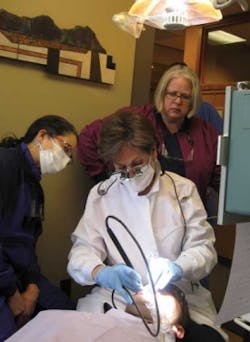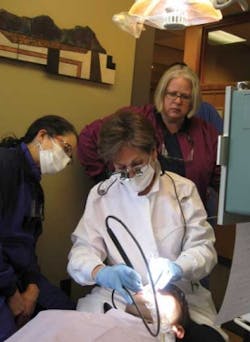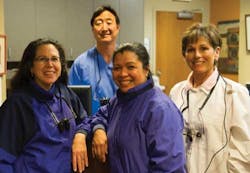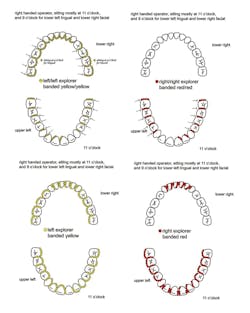Let it shine, or do it blind
Eavesdropping on a Perioscopy seminar
by Lynne Slim, RDH, BSDH, MSDHSuzanne Newkirk, RDH, and I had our best conversations while power walking in her suburban Seattle, Wash., neighborhood. We're a lot like Forrest Gump: we could jog clear across America nonstop if given the opportunity. Suzanne is one of those determined hygienists who revitalized her career in a way many of us can only dream about. She has many people to thank for empowering her, and her career pathway has been illuminated (no pun intended) in more ways than one. I'd like to tell you more about her success.
I don't recall how Suzanne and I first met, but we started e-mailing each other fairly regularly in late 2010. She invited me to fly out to her beloved State of Washington and spend about five days with her in two different but spectacular dental practices where I would observe her teaching and performing Perioscopy. Truth be told, my expectations were exceeded, and the cast of characters I met along the way made the experience even more worthwhile.
I arrived at her home on a cold night in the middle of winter and was greeted by her ebullient husband, Dick. He kept referring to Suzanne as 'Duck,' a nickname that confused me at first, especially when he asked me about Duck's whereabouts the morning after my arrival. Granted, I was suffering from jet lag even after my second cup of Dick's freshly brewed espresso, but I didn't think my brain was completely numb at that point. I was also well aware that it rains a lot in Seattle (rendering most people sleepy, not sleepless), but I didn't think pet ducks were common indoor pets. Even so, I glanced around their digs for some sign of a pet, and all I could see was a pet cat named Schmoozer.
The weekend of my arrival, Suzanne and periodontist John Y. Kwan, DDS, were scheduled to do some in-office Perioscopy training at a nearby periodontal practice that is owned by another periodontist, Donna L. Massoth, DDS, MSD, PhD. Suzanne first met Donna when she hired Suzanne to perform Perioscopy for her patients. She found Suzanne on Dr. Kwan's Web site, perioscopyinc.com where she was listed as a Washington State provider. Suzanne's business address is perioscopyprofessionals.com. Donna and her two talented hygienists, Maryknoll Hunter, RDH, and Patsy Berg, RDH, would spend a day-and-a-half with Suzanne and John, challenging and retraining themselves in a way that would forever change their manner of envisioning, albeit blindly, the subgingival pocket ecosystem.
Suzanne Newkirk, RDH, and Patsy Berg, RDH, with the simulator.
Donna warmly greeted the three of us, and we quickly moved from the reception area to the operatories where Suzanne and John assembled the Perioscopy equipment. Perioscopy is no longer taught the way it was in the 1990s by DentalView. John, in particular, has cleaned more than 10,000 teeth endoscopically using two hands, both feet, and a screen to visualize the pocket environment. Like John, Suzanne is a Perioscopy trainer who is proficient in the two-handed technique. Both trainers emphasize the importance of approaching the two-day training with an open mind. They cautioned against prejudicing the experience with a fixed or inflexible mind-set. While they were still preparing for the day's clinical teaching session, John talked to me at length about traditional dental hygiene's obsession with aggressive, blind scaling that frequently hacks up roots. Another one of John's pet peeves is the notion of cleaning first and then scoping to check one's work. In medicine, laparoscopic nonsurgical procedures are nonblind, meaning the surgeon views while instrumenting. John uses a lot of unique metaphors to explain how to become proficient at Perioscopy. As a pole vaulting coach, he emphasizes that you don't jump 10 feet without a lot of practice and a desire to be there.
The morning practice session began with a warm-up exercise that involved the Wii bowling game. Playing with the Wii trains the mind to look at a screen while doing something with the nondominant hand. Research studies have suggested a possible link between video-gaming and laparoscopic skill. According to John, medical students who are learning to perform gallbladder surgery laparoscopically receive Wii training. Surgery residents who are doing simulator training for endoscopic gall bladder removal perform better after warming up on the Wii.
After this training and sucking down more coffee in the break room (I'm mostly referring to me here), Donna, Maryknoll, and Patsy learned to insert the endoscopic explorer subgingivally on a typodont, and were coached to learn how to use the various explorers. Paper charts showing locations on a tooth where explorers can be adapted were available for viewing while practicing (see Figure 1). After they learned to adapt to the different explorers and practiced assembling the sheath and fiber-optic camera, they then practiced holding the ultrasonic insert in their dominant hand and the explorer in their nondominant hand, and focused on visualizing the tooth/root surface on a Perioscopy simulator screen. The Perioscopy simulator is portable and can be used in almost any clinical setting. This allows students to practice with typodonts and learn to adapt explorers and ultrasonic inserts at their own pace.
As the three willing students practiced on typodonts in preparation for patients later in the day, certain points were emphasized. Inserting the sheath into the explorer is an art in itself and requires some practice to get it right. It requires twisting a tip seal just right and then securing the sheath into the Perioscopy explorer to make it ready for use. In addition, proper sheath placement ensures safe removal. To eliminate cord tension, John and Suzanne teach students to wrap the ultrasonic handpiece cord between the ring and pinkie finger. John and Suzanne prefer magnetostrictive ultrasonic instrumentation, and they use a Tony Riso manually tuned machine.
Upper quadrants (roots) take longer to clean than lower quadrants, mainly due to the complex anatomy of the maxillary posterior teeth. Two quadrants will take about two hours to complete, and the administration of local anesthesia is necessary. While local anesthesia is taking effect, it's a good idea to lightly debride the quadrant(s) to remove plaque/biofilm so that it doesn't interfere with endoscopy. Tactile debridement is done just before endoscopic debridement to reduce plaque/biofilm, gross calculus, effect pocket dilation, and get a feel for pocket anatomy.
Suzanne asked the students to hold the explorer(s) with a pen grasp. She made a point of telling them that learning periodontal endoscopy teaches you a lot about root morphology. John also pointed out that he works without an assistant while performing this procedure, so this treatment is well-suited for the hygienist. He's particular about positioning the saliva ejector, depending on where he's working, and he likes to cover the saliva ejector tips with cushion foam covers. (He refers to them as suction mufflers.)
Magnetostrictive micro ultrasonics
Both John and Suzanne prefer magnetostrictive micro ultrasonic instrumentation, and they use a 25/30 K model with 25 K inserts. Micro ultrasonic instrumentation refers to insert tips that are small (the size of a perio probe) for supra- and subgingival debridement, with low to high power settings, and a low-water spray. Suzanne uses very few hand curettes (her favorite is the Barnhart # 5/6 and a sickle scaler for anterior teeth), and John hasn't used a hand curette for cleanings in almost 20 years. The 25 K inserts are all metal with external water cooling tubing. Right and left inserts are bent to better fit concavities and furcations in posterior teeth. (See demonstration videos at www.perioscopyinc.com for more information on micro ultrasonics and Perioscopy). John has found from experience that there's more insert wobble at 25 K and it cleans faster, so he prefers 25 K to 30 K or piezo at 40 K. He frequently buys rebuilt inserts and likes the idea that they can be recycled.
Perioscopy demo on patients
Later that morning, surrounded by their three eager students, John and Suzanne started "scoping" patients following the administration of full-mouth local anesthesia. John likes styrofoam bite blocks to hold the patient's mouth open, and after tuning the ultrasonic unit, his protocol is to do tactile debridement just before endoscopic debridement, moving around the mouth in sextants or quadrants. He uses the straight ultrasonic insert in the UL quadrant to deplaque and knock off visible chunks of supragingival calculus. One month ahead of full-mouth Perioscopy, John starts his patients on a home oral irrigation system (Waterpik® or Oral Breeze products.) Systemic antibiotics are used either before or at the time of treatment. These protocols are outlined on the Perioscopy Inc. Web site demonstration videos. Both John and Suzanne wear loupes and headlights, and Suzanne has purchased her own.
Conversation came easily that particular morning and I thought I'd include a bit of the dialogue. Most of the comments were made by Dr. Kwan while he was methodically "scoping" a patient. He assumes an 11:00 position for most of the quadrants he's working on.
"This is so much easier than surgery, and I can delegate the entire procedure to a dental hygienist," said John.
"I sometimes get a Nabors probe and ortho pliers and curve the right and left insert when I'm in the mood to adapt my own inserts."
"Practice makes perfect and it's all about instrument adaptation."
"When you're learning Perioscopy, you leave your ego at the door."
"What if a student says I don't want to visualize the pocket?" I then say, "Are you kidding me?"
"Not everyone can be a pole vaulter and not everyone can play the Wii."
"I count 'sheaths' (not sheep!) to figure out how many Perioscopy cases are being done around the world."
"I am the 'Scope' Evangelist" says a self-confident Dr. Kwan, and he's proud of that description.
"Who'da thunk it?" jokes Kwan as he thinks about the intellectual and technological leap that Perioscopy provides.
While John continued "scoping" with a couple of students peering over his shoulder, I turned my attention to Suzanne in the adjacent operatory. She was working with Knoll on the typodonts. Suzanne admits she practiced for hours on end with her typodont at home while learning Perioscopy, and she never gave up. She uses finger "rests" with both hands, even while working on typodonts. In Perioscopy, a finger "rest" on a tooth or cheek/chin works well.
"Patience is the word of the day when learning Perioscopy," insisted Suzanne.
"Knoll, take your tip to the light and take tiny strokes – slowly – go to the mesial and find the furcation while thinking about root anatomy."
"Visualize what you're seeing on the screen," Suzanne said in a low and gentle tone of voice.
"Tissue, calculus, shield – try to see where you are right now and follow the light. Then go onto the tooth."
"Slow it down, Knoll. You're going way too fast. If you lose your way, go back to the CEJ."
"Do the wiggle with the insert."
Suzanne encouraged Knoll to talk out loud while practicing and direct all of her efforts in that elusive but now "visible" sulcus.
Midmorning break
As I sipped my Starbucks vanilla double latte soy in the break room, my mind wandered, and I began to think about the history of the Starbucks company. I wasn't sitting too far from where the first store opened (1971) in touristy Pikes Place Market in downtown Seattle. Starbucks now boasts about having more than 16,000 stores in 48 countries. And just how will Perioscopy fare in about 30 years' time?
Here's a bit of Perioscopy trivia you might not know. Perioscopes are being widely used in treatment and research in the United States, Ireland, England, Scotland, Germany, Italy, New Zealand, Australia, and Bulgaria. John has had inquiries from India, Brazil, Peru, China, Japan, Korea, Venezuela, Romania, and Pakistan. Use ranges from less than five times a year to more than 400 procedures. The dental practices that use Perioscopy regularly rarely do surgical debridement, because the results are so positive and the majority of the procedures are performed by hygiene staff!
Break over
Patsy's turn and she's performing Perioscopy on a patient. I settle onto the operatory stool, trying hard to be inconspicious and listen in on the dialogue between Suzanne, John, and Patsy.
Patsy begins at the lingual surface of tooth No. 2. "Twist the insert according to where you want it to go – just like you take a probe and put it in a pocket."
"When you close the angle between the tooth and the scope, you can see it better."
"Make your movements smaller."
"You'll see a ton of plaque biofilm on the root and crown margins."
"See that little piece of calculus right there? You're close."
"Go to the midpalatal of tooth No. 3. Close the angle between the tooth and the scope," says Kwan.
"Water has to be contained between the camera and the tooth so you can look right through the water."
"Now, go into the mesiolingual of tooth No. 3 because there's a pocket there – let the screen guide your movements."
"You get good at this and you're golden," insists Kwan.
"You've got the camera in the right spot. Now, twist the ultrasonic tip so you can get at the calculus and pulverize it."
Kwan's and Newkirk's Perioscopy doctrine
John and Suzanne's enthusiastic commitment to Perioscopy is contagious, and it just makes sense not to work blind. Just for the fun of it, go to this Web site – http://www.insidestory.iop.org/insidestory_flash1.html – and see how easy it is for a clinician to navigate around a large intestine endoscopically while performing a colonoscopy.
Does it make any sense to attempt nonsurgical debridement in a deep, dark ravine (pocket ecosystem) without light and vision? Are we kidding ourselves into naively thinking we can "heal" a deep pocket nonsurgically with blind instrumentation and a sprinkling of some locally delivered antimicrobial?
By the way, there's a new virtual textbook on Perioscopy. Go to the Perioscopy Web site at www.perioscopyinc.com to view the collection of demonstration videos. Next, think seriously about purchasing an endoscope. Contact John on the perioscopyinc.com Web site and you'll find sellers who are selling theirs for as little as $2,500. It makes good sense for group practices to train hygienists to "scope" perio cases because they see a lot of untreated periodontal disease. Once you purchase an endoscope, training is essential. Currently, there are about seven qualified Perioscopy trainers in the United States. John Kwan and Suzanne Newkirk come highly recommended as trainers. John mentioned that Bonnie Francis, Mikelle Watson, and Gayle Meyers are the original DentalView trainers, and they teach piezo ultrasonics and hand instrumentation. Trainers from Perioscopy Inc. will assist you with coding/pricing and scheduling issues. John spent about an hour discussing these important business considerations with Dr. Donna Massoth and her practice manager while I was there.
John jokes (but he's really being serious) with his students about a patient who asked him the following question: "Isn't your vision fundamental to what you do?" I often think about this when I'm working blind nonsurgically around posterior sextants ... and to be perfectly frank, I'm not at all confident about what I'm doing. I've stared at the Perioscopy screen long enough to recognize the absurdity of attempting it blind and expecting resolution of pocket inflammation.
A dear colleague of mine (a talented writer) just finished a short story on learning how to ride a bicycle. He asked me to review it and I finished reading it about a week ago. He described the agony of scraped and bloodied knees and the ecstasy and pride of pedaling to success. The story moved me, and I immediately compared this simple victory to that of Perioscopy training. Once you get it, and once you experience the highs of working smart – not blind! – you'll be hooked.
Lynne Slim, RDH, BSDH, MSDH, is an award-winning writer who has published extensively in dental and dental hygiene journals. Lynne is the CEO of Perio C Dent, a dental practice management company that specializes in the incorporation of conservative periodontal therapy into the hygiene department of dental practices. Lynne is also the owner and moderator of the periotherapist yahoo group: www.yahoogroups.com/group/periotherapist. Lynne speaks on the topic of conservative periodontal therapy and other dental hygiene-related topics.
Past RDH Issues




